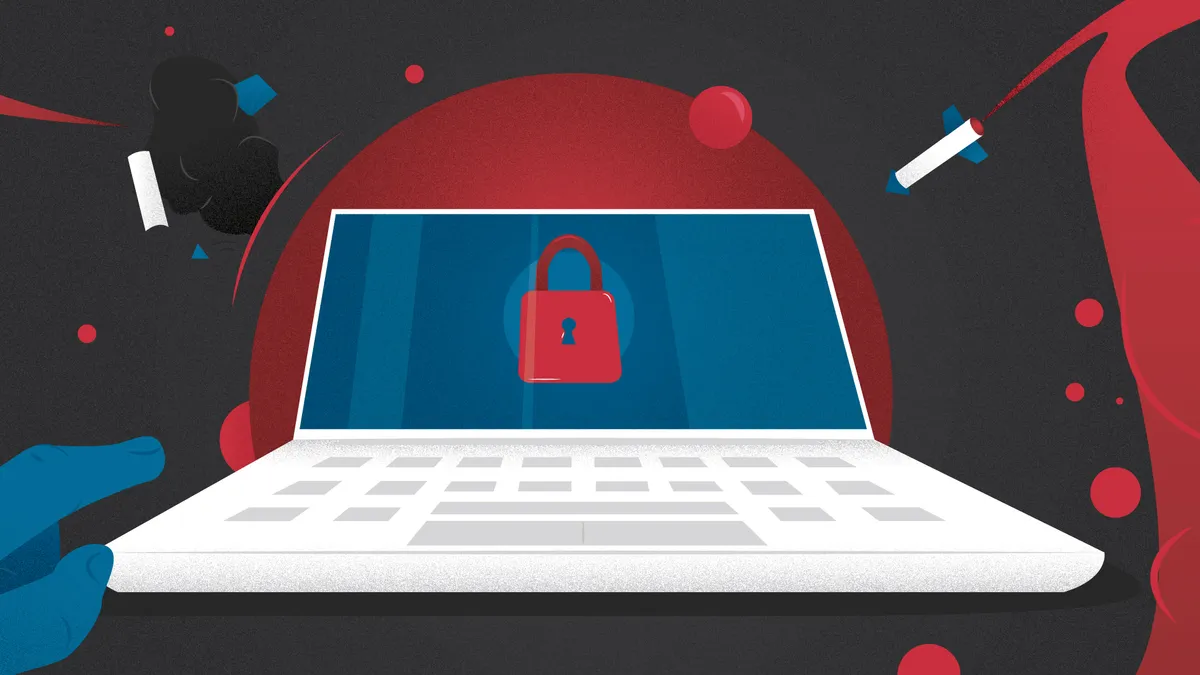The security landscape of Symantec's origins bears a faint resemblance to the threats of today.
The cybersecurity firm, while announcing respectable earnings for Q1 FY19, has seen substantial changes in the last several years, including acquisitions, new leadership and an internal audit. This does not bode well considering hackers are always two steps ahead of cybersecurity solutions.
One of the issues Symantec, and legacy companies like it, faces is a slowdown of innovation and the perception of relaxed marketing strategies. Right now customers and investors need reassurance in the progress and reliability of security vendors.
"While this is often without merit, Symantec (along with McAfee, and to a lesser extent ESET, Kaspersky and Trend Micro) have struggled to loudly exert their dominance or authority in the endpoint space," said Ian McShane, research director at Gartner, in an email to CIO Dive.
Though Symantec's stock took a notable hit since May because of the revelation of its internal investigation, its products remain viable. And yet the dark cloud of the audit remains.
An analyst's perspective
Instead of switching security vendors, companies could see value in what the audit brings to light, said McShane.
Yes, Symantec has made systematic changes to its business in recent years, but McShane said: "Symantec had seemed on a good reinvention track — especially on the endpoint protection and [endpoint detection and response] front with strong technology acquisitions and organic enhancements."
Symantec experienced longer sales cycles in enterprise security in Q1, according to the company's most recent earnings report. McShane said the company had a number of deals that didn't close when expected and pipeline management in North America contributed to the delays.
The company remained hush on the details of the longer sales cycle, whether it was tied to new business, renewals or impacts on product lines. With the audit in progress, Symantec declined to comment on the record. But Symantec's product portfolio is substantial, when "compared to the pure play endpoint vendors," which means it sells to multiple buyers, all impacting its sales cycle, according to McShane.
"Symantec had seemed on a good reinvention track – especially on the endpoint protection and [endpoint detection and response] front with strong technology acquisitions and organic enhancements."

Ian McShane
Research Director at Gartner
It's in Symantec's best interest to protect its renewals, but without evidence of strong sales or the prowess of effective marketing, new business may not be on the horizon for now, said McShane, for Symantec and all endpoint protection (EPP) vendors.
Replacing an EPP is daunting. Existing enterprise customers have to undergo a lengthy process to replace an EPP provider entirely and most organizations resist doing so unless there are plans to adopt managed services in a broader security strategy, he said.
McShane noted that existing Symantec customers are most likely satisfied with the enhancements made over the last 18 months. But there are two areas of concern:
- " ... a vendor simplification go-to-market,"
- " ... the lack of common consoles or interaction across some areas makes it harder to displace existing competitor solutions, unless there is already a catalyst for change within the prospect organization."
A few years paint a picture
Symantec made a number of changes over the last few years in an attempt to refocus its offerings and stick with what elicits the most success and divests itself of unnecessary burdens.
The company announced it was offloading its data storage business Veritas in 2015 as its revenues continued to slump. Symantec had bought the company 10 years earlier, but during that time demand for storage and data management software decreased.
Symantec's then-CEO and president Michael Brown stepped down in April 2016. By August 2016, Greg Clark assumed the role. Before Clark took the role, the company announced plans to cut 1,200 employees in June 2016.
The plan was similar to Symantec's Q1 earnings where CFO Nicholas Noviello revealed the company's plan for internal restructuring in FY19 to cut spending by $115 million and its global workforce by 8%.
But around August of last year, and five months after Google downgraded its trust in SSL certificates, Symantec sold its Website Security and PKI solutions to DigiCert to refocus on what it was founded on — enterprise security and its cyber defense platform.
-
February 2015
Announces the approval of a $1 billion share repurchase program
-
August 2015
Announces its selling Veritas
-
April 2016
CEO Michael Brown steps down
-
June 2016
Report surfaces of a cost savings and employee restructuring plan
-
July 2016
Announces appointment of Michael Fey as president and COO upon completion of Blue Coat acquisition
-
August 2016
Finalizes purchase of Blue Coat
-
August 2016
Greg Clark assumes the position as CEO
-
November 2016
CFO Thomas Seifert announces departure and Nick Noviello assumes role
-
March 2017
Google announces plans to distrust Symantec’s old SSL certificates and reduces the accepted validity of newly issued certificates
-
August 2017
Reaches agreement to sell its Website Security and PKI solutions
-
May 2018
Announces an internal investigation raised by a former employee and is taken up by the Securities and Exchange Commission
-
August 2018
Announces a restructuring plan for FY19, including an 8% cut to its global workforce
-
August 2018
Receives a Nasdaq deficiency notice after delaying its 10-Q due to the internal investigation
-
August 2018
Confirms the receipt of five nominees from hedge fund Starboard Value to the Symantec Board of Directors
Symantec’s major changes from the last 3 years
In 2016 the company finalized its purchase of Blue Coat and was said to cement Symantec as the industry's "largest pure play cybersecurity company." The deal was meant to combine Symantec's existing "threat telemetry" and Blue Coat's ability to protect users from threats on a network, the web, on mobile or in the cloud, according to the announcement.
Symantec paid $4.65 billion cash for Blue Coat, a nod to the impressive cash load the company still carries. The acquisition was intended to usher in an era and yet two years later, innovation is stagnant.
Symantec continues to try new things like moving to the cloud, creating an enterprise platform, still the question remains "are they moving fast enough," said John Gomez, CEO of Sensato, in an interview with CIO Dive. But in all fairness, "I guess you can ask that of anybody."
Notably, much of Symantec's corporate leadership today carried over from the Blue Coat acquisition. President and COO Michael Fey, EVP and CFO Nicholas Noviello, chief strategy officer Brian Kenyon and CTO High Thompson are all among the executives who continued their roles at Symantec.
The Blue Coat acquisition gave Symantec leadership "with a proven track record in successful execution" and a "stable leadership team for the first time in a number of CEO tenures," according to McShane. The stability from the change in leadership has a constructive impact on engineering and product improvements, which ultimately leads to customer benefits.
What about the audit
In May, during the company's Q4 FY18 earnings, Symantec announced an internal investigation by the Audit Committee of the Board of Directors. The audit is a result of a former employee raising concerns about financials, but no other details were provided.
Symantec "voluntarily" contacted the Securities and Exchange Commission (SEC) to inform the agency of the investigation and will provide additional information as it continues. At the time of the announcement, the company relayed that its financial findings and guidance "may be subject to change based on the outcome."
The company is working to gather information and once all of the evidence has been collected, it will submits findings to the SEC.
But in August, during its Q1 FY19 earnings announcement, the company said it had yet to file its annual report on Form 10-K for FY18 and Q4 FY18 while leaving subsequent periods open "from an accounting perspective" that could change based on the results of the investigation.
"There's opportunity in the market right now for an Apple of cybersecurity."

John Gomez
CEO of Sensato
"The company can't be held liable for inaccuracies in that release under the rules that apply to [10-Q and 10-K] filings," said Anders Bylund, technology and entertainment specialists for Motley Fool, in an email to CIO Dive.
"The review is a bad omen but we just don't have enough information yet to lock in the 30% price drop for good," said Bylund. The severity of the audit is unknown though it signals investors can't trust reported finances.
Even if restatements are inevitable, it's not the worst that could happen, according to Bylund.
Bylund pointed out that Apple underwent a similar internal investigation in 2006. The company had to review some stock option grants from 1997 to 2001 and by Q1 FY07, the company's revenue was a record $7.1 billion, according to the announcement.
Innovation is an industrywide issue
The cybersecurity market is competitive and saturated with vendors offering similar solutions. Secureworks, IBM and Verizon all align, if not slightly outpace Symantec as leaders in Gartner's 2018 Magic Quadrant for Managed Security Services.
However, the composition of the Quadrant is not something that can wholly judge Symantec's capabilities. From an enterprise customer's point of view, many of the cybersecurity solutions on the market today are the same with very little difference.
"There's opportunity in the market right now for an Apple of cybersecurity," said Gomez. In terms of a leader in innovation if financial results are put aside, Gomez doesn't really see one.
Right now cybersecurity is reminiscent of the days when there were 10 to 12 Word processors, he said. "At the end of the day you kind of scratch your head and go 'what really is the difference between Microsoft Word and Wordperfect?' "
Security experts say Symantec can't slash too many products because its too reliant on them. Firms like Symantec and LifeLock are in a challenging position because they can't afford to cut products customers are still buying products and are satisfied with them.
"You have to innovate your way out of this," Gomez said. This is an industrywide issue, not one relegated to Symantec. It's a challenge to innovate without losing position in the market. The company has an "amazing group for threat intelligence, but that's threat research, not technical research."






















